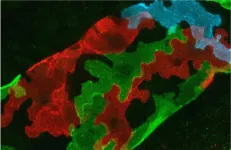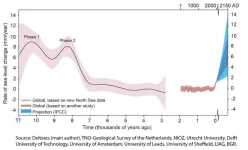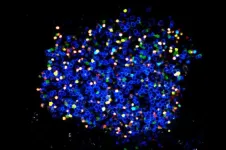(Press-News.org) By revealing for the first time what happens in the brain when an animal makes a mistake, Johns Hopkins University researchers are shedding light on the holy grail of neuroscience: the mechanics of how we learn.
The team pinpointed the exact moment mice learned a new skill by observing the activity of individual neurons, confirming earlier work that suggested animals are fast learners that purposely test the boundaries of new knowledge.
The federally funded work, which upends assumptions about the speed of learning and the role of the sensory cortex, and which the researchers believe will hold true across animal species including humans, is newly published in Nature.
“Looking at a tiny part of the brain in a mouse, we can understand how the brain learns, and we can makes predictions about how the human brain might work,” said Kishore Kuchibhotla, a Johns Hopkins neuroscientist who studies learning in humans and animals. “The field of neuroscience has made great progress decoding motor activity and how the brain processes sight and sound. But a holy grail of this type of research is thought—what comes between the hearing and the doing—we’re all still trying to understand the patterns of brain activity that underly higher-order cognitive processes. These findings are a step in that direction.”
Although the ability to learn quickly would benefit any animal in the wild, animals studied in labs seem to learn slowly and methodically. It typically takes mice, for instance, thousands of tries to learn a task, several hundred at best.
Kuchibhotla’s lab previously found that animals’ performance doesn’t necessarily sync with their knowledge—or that animals might know a lot more than they demonstrate in tests. The lab also found that animals that seem to be slow learners might be testing their new knowledge. But by merely watching animals struggle at tasks, they couldn’t tell a slow learner from a strategic tester of boundaries.
“We are interested in the idea that humans and other animals may know things about the world, things that they choose not to show,” Kuchibhotla said. “Our core question is what is the neural basis of this distinction between learning and performance.”
The researchers taught mice to lick when they heard one tone but not to lick when they heard a different sound. From the moment training began, the team recorded the activity of neurons in the auditory cortex, an area of the brain associated with hearing and perception.
There were two major surprises. First, the mice learned in 20 to 40 tries, “extraordinarily fast,” according to Kuchibhotla. And second, this learning activity happened in the sensory cortex, something that has typically been associated with nonsensory brain areas.
“This work illustrates the importance of assessing how brain activity impacts behavior at different stages of the learning process and in different conditions,” said first author Celine Drieu, a postdoctoral fellow studying neuroscience at Johns Hopkins. “Our results show that a sensory cortex does more than processing sensory inputs; it is also crucial to form associations between sensory cues and reinforced actions.”
When the mice continued to make errors, licking at the wrong times long after their neural activity showed they’d learned the task, their brain activity confirmed to the researchers that the mice knew the rules of the game—they were just experimenting.
‘We were able to decode the cognitive driver of an error,” Kuchibhotla said. “We could tell if the animal was making a mistake or just wanted to give the other option a shot.”
Once the mice had mastered the task and ceased their exploratory behavior, this higher-order activity started to diminish, and the sensory cortex was no longer involved in the task.
“We think this means that animals are smarter than we think, and that there are distinct brain dynamics related to learning. You might know something, but there’s a parallel process related to how you use it. The brain seems wired to do that well, to allow us to toggle between performance and learning as we get better and better at something.”
END
Brain imaging reveals surprises about learning
Researchers for 1st time use brain activity to determine why mice make mistakes
2025-03-19
ELSE PRESS RELEASES FROM THIS DATE:
Scientists see the first steps of DNA unwinding
2025-03-19
For the first time, scientists have witnessed the very moment DNA begins to unravel, revealing a necessary molecular event for DNA to be the molecule that codes all life. A new study from King Abdullah University of Science and Technology (KAUST), published in Nature, captures the moment DNA begins to unwind, allowing for all the events that follow in DNA replication. This direct observation sheds light on the fundamental mechanisms that allow cells to faithfully duplicate their genetic material, a cornerstone for growth and reproduction.
Using cryo-electron microscopy and deep learning to observe the helicase ...
Earliest stages and possible new cause of stomach cancer revealed
2025-03-19
For the first time, scientists have systematically analysed somatic mutations in stomach lining tissue to unpick mutational processes, some of which can lead to cancer. The team also uncovered hints of a potential new cause of stomach cancer that needs further research.
Researchers at the Wellcome Sanger Institute, Broad Institute of MIT and Harvard, the University of Hong Kong, and their collaborators sequenced the whole genomes of normal stomach lining samples from people with and without gastric cancer.
The team ...
Unique cell shape keeps lymphatic vessels and plant leaves stable
2025-03-19
The cells that make up the walls of the finest of all lymphatic vessels have a lobate, oak leaf-like shape that makes them particularly resilient to changes in fluid volume. A similar cell shape also supports mechanical stability in plants. This has been shown by researchers from Uppsala University in a new article published in the journal Nature.
The lymphatic system consists of a network of lymph vessels that maintains the body’s fluid balance and supports the immune system. The finest of all these lymphatic vessels are called lymph capillaries. They have walls that are made up of just a single layer of lymphatic endothelial ...
New understanding of B cell mutation strategies could have implications for vaccines
2025-03-19
A vaccine's ability to generate long-lasting, high-affinity antibodies hinges on a delicate balance. Upon exposure to a vaccine or pathogen, B cells scramble to refine their defenses, rapidly mutating in hopes of generating the most effective antibodies. But each round of this process is a roll of the genetic dice—every mutation has the potential to improve affinity; far more often, however, it degrades or destroys a functional antibody. How do high-affinity B cells ever beat the odds?
New research now suggests that B cells avoid gambling away good mutations by strategically banking successful ones. As described in Nature, ...
Sea level rise after the last ice age: More knowledge
2025-03-19
New geological data has given more insight into the rate and magnitude of global sea level rise following the last ice age, about 11,700 years ago. This information is of great importance to understand the impact global warming has had on the ice caps and on sea level rise. The findings have been published in the scientific journal Nature by researchers from Deltares, Utrecht University, TNO Netherlands Geological Service, Delft University of Technology, the Netherlands Institute for Sea Research (NIOZ), University of Leeds, University of Sheffield, University of Amsterdam, LIAG and BGR.
Better ...
New mechanism behind adaptive immunity revealed. It could impact how we design vaccines.
2025-03-19
Germinal centers are high-speed evolution machines. Tiny clusters in the lymph nodes, germinal centers refine antibodies through mutation and expansion until they produce high-affinity B cells adapted to keep different pathogens in check. But rapid evolution should come at a cost. Most mutations are deleterious, so constant mutation during every cell division, coupled with unchecked proliferation, should be a recipe for disaster. How B cells somehow rapidly mutate and improve all at once was a long-standing mystery.
Now, advanced imaging techniques reveal the ...
Hyperuricemia: Current state and prospects
2025-03-19
Hyperuricemia (HU) is a metabolic disorder characterized by elevated uric acid (UA) levels in the bloodstream, commonly diagnosed when UA levels exceed 420 µmol/L (7 mg/dL) in men and 350 µmol/L (6 mg/dL) in women. Unlike other mammals, humans lack uricase, an enzyme that breaks down UA into a more soluble form, making them more susceptible to HU. The condition is influenced by genetic, dietary, and environmental factors, with contributors including purine-rich foods, metabolic dysfunctions, obesity, and ...
What happens in the male mouse brain during sex
2025-03-19
To uncover what drives sexual behavior in animals, researchers studied the brain activity of male mice throughout the series of actions involved in sex leading up to ejaculation. Their results, publishing in the Cell Press journal Neuron on March 19, show that the intricate dance in the brain area responsible for pleasure between two chemicals—dopamine and acetylcholine—controls the progression of sexual behavior. These findings could inspire treatments for disorders like premature ejaculation.
“Sexual behavior is a complex sequence of events,” says senior author Qinghua Liu of the National ...
Prescription stimulant use, misuse, and use disorder among US adults ages 18 to 64
2025-03-19
About The Study: Although access to prescription stimulants is essential to addressing important clinical needs of patients with attention-deficit/hyperactivity disorder (ADHD), this study found that among U.S. adults ages 18 to 64 using prescription stimulants, one-fourth reported misuse, and nearly one-tenth had prescription stimulant use disorder. The findings may suggest potential progress in addressing the mental health care gap for middle-aged women and the need for evidence-based clinical guidance and training on benefits ...
Suicide and self-harm events with GLP-1 receptor agonists in adults with diabetes or obesity
2025-03-19
About The Study: There is unlikely to be an increase in the very low incidence of suicide-related adverse events among individuals receiving glucagon-like peptide 1 receptor agonists (GLP-1 RAs) within the context of randomized clinical trials. While these findings may further ease concerns about these adverse effects, continued monitoring is warranted to identify particular patients who may be at risk as extended use of GLP-1 RAs expands.
Corresponding Author: To contact the corresponding author, Sean P. Heffron, MD, MS, MSc, email sean.heffron@nyulangone.org.
To access the embargoed study: ...
LAST 30 PRESS RELEASES:
When is it time to jump? The boiling frog problem of AI use in physics education
Twitter data reveals partisan divide in understanding why pollen season's getting worse
AI is quick but risky for updating old software
Revolutionizing biosecurity: new multi-omics framework to transform invasive species management
From ancient herb to modern medicine: new review unveils the multi-targeted healing potential of Borago officinalis
Building a global scientific community: Biological Diversity Journal announces dual recruitment of Editorial Board and Youth Editorial Board members
Microbes that break down antibiotics help protect ecosystems under drug pollution
Smart biochar that remembers pollutants offers a new way to clean water and recycle biomass
Rice genes matter more than domestication in shaping plant microbiomes
Ticking time bomb: Some farmers report as many as 70 tick encounters over a 6-month period
Turning garden and crop waste into plastics
Scientists discover ‘platypus galaxies’ in the early universe
Seeing thyroid cancer in a new light: when AI meets label-free imaging in the operating room
Neutrophil-to-lymphocyte ratio may aid risk stratification in depressive disorder
2026 Seismological Society of America Annual Meeting
AI-powered ECG analysis offers promising path for early detection of chronic obstructive pulmonary disease, says Mount Sinai researchers
GIMM uncovers flaws in lab-grown heart cells and paves the way for improved treatments
Cracking the evolutionary code of sleep
Medications could help the aging brain cope with surgery, memory impairment
Back pain linked to worse sleep years later in men over 65, according to study
CDC urges ‘shared decision-making’ on some childhood vaccines; many unclear about what that means
New research finds that an ‘equal treatment’ approach to economic opportunity advertising can backfire
Researchers create shape-shifting, self-navigating microparticles
Science army mobilizes to map US soil microbiome
Researchers develop new tools to turn grain crops into biosensors
Do supervised consumption sites bring increased crime? Study suggests that’s a myth
New mass spec innovation could transform research
Maternal nativity, race, and ethnicity and infant mortality in the US
Migration-related trauma among asylum seekers exposed to the migrant protection protocols
Jupiter’s moon Europa has a seafloor that may be quiet and lifeless
[Press-News.org] Brain imaging reveals surprises about learningResearchers for 1st time use brain activity to determine why mice make mistakes




